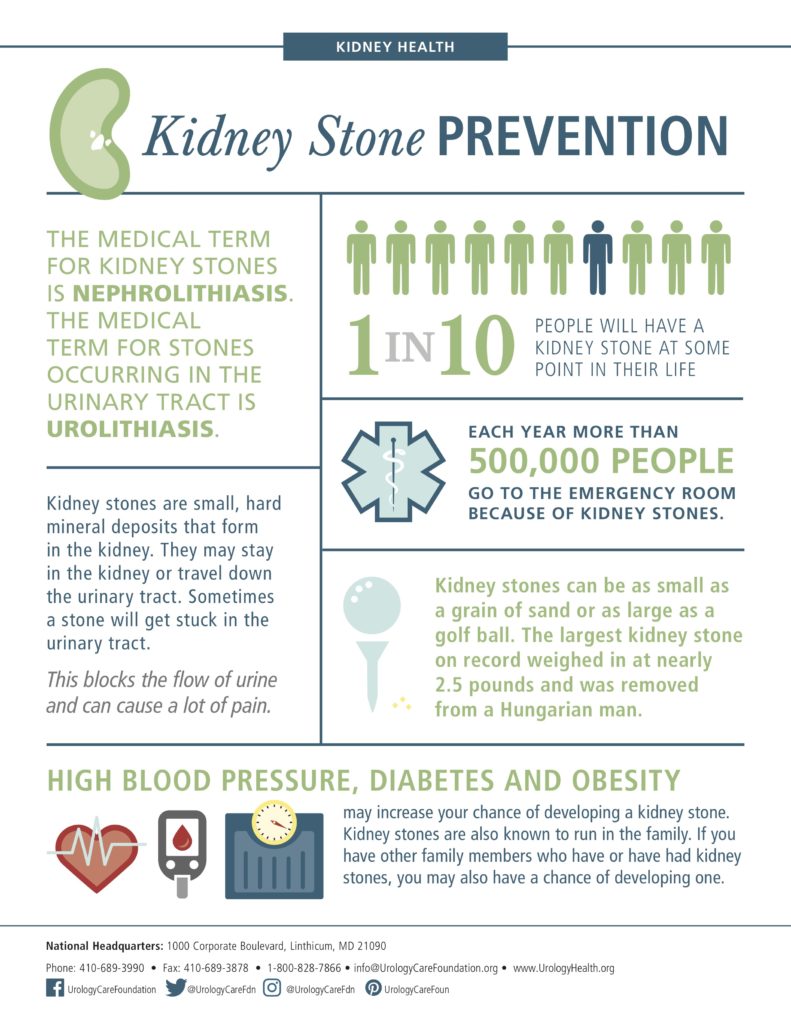Kidney Stones – Cause, Symptoms, and Treatment
7/17/2019
Kidney stones. Even saying it sends chills down the spine of someone who has experienced them. But what exactly are they? Well, it’s simple really; kidney stones are formed when urine has high levels of dissolved minerals or salts. They can start small but grow larger in size, even to the point to where they begin filling the inner hollow structures of the kidney. Now you may be asking yourself a few very common questions, what causes kidney stones, how do I know I have them, and what can I do about it? Lucky for you, we’re here to help.
Before we jump right into the cause, let’s take a moment to talk about the kidneys. The kidneys are fist-size organs that handle the body’s fluid and chemical levels. Most humans are naturally equipped with a set of two, one on either side of the spine behind the liver, pancreas, stomach, and intestines. When they’re healthy, they clean waste from the blood and remove it from the urine. When they’re not, well, kidney stones may begin forming.
Kidney stones develop in the kidney, and some stones move from the kidney into the ureter. The ureters are tubes that lead from the kidneys to the bladder. If there’s a stone that leaves the kidney and gets stuck in the ureter, it’s called a ureteral stone. For the remainder of this article, we’ll only be referring to kidney stones.
Kidney stones come in a variety of types and colors, and the treatment depends on which type you have. Calcium stones, which make up about 80% of stones, are the most common. In fact, there are two types of calcium stones: calcium oxalate and calcium phosphate. Calcium oxalate is by far the most common of the two. Some individuals have too much calcium in their urine, which obviously raises the risk of developing these calcium stones. Even people with normal amounts of calcium in their urine can still develop calcium stones for other reasons.
Uric acid stones account for 5-10% of all kidney stone cases. Uric acid is a waste product that comes from chemical changes in the body. Uric acid crystals are not dissolved well in acidic urine and will form a uric acid stone instead. This may be caused by chronic diarrhea, Type 2 diabetes, gout, obesity, or a diet that is high in animal protein and low in fruits and veggies.
Struvite stones are not common, but still make up about 10% of all kidney stone cases. These stones are linked to reoccurring urinary tract infections. Some bacteria make the urine less acidic and more basic or alkaline. Magnesium ammonium phosphate, or struvite, stones form in alkaline urine. These are often large, with branches, and they usually have an expedited growth rate.
The least common kidney stones are cystine stones. Cystine is an amino acid that is in certain foods; it is one of the building blocks of protein. Too much cystine in the urine, also known as cystinuria, is a rare and inherited metabolic disorder. This occurs when the kidneys do not reabsorb cystine from the urine. These stones often form in your childhood.
Causes
One of the major factors of kidney stones can be constant low urine volume. This can develop from dehydration from exercise, living in a hot place, or not drinking enough fluids. Dehydration affects your kidneys and can create a disruption in the removal of waste from the body. Severe dehydration can lead to kidney damage, so it’s vital that you drink enough with you work or exercise very hard, especially in warm and humid weather. While we’re on the topic of hydration, not all fluids are as nourishing as one may think. Water is a healthier choice than those high-calorie sugary drinks. Water assists the kidneys in removing the waste from your blood and also helps keep your blood vessels open so that blood can travel uninhibited to your kidneys, and provide those essential nutrients. It’s recommended that adults consume eight glasses of water a day to maintain proper hydration.
As cliché as it sounds, your diet and what it consists of, can affect the chance of forming kidney stones. One of the more common causes of kidney stone formation is high levels of calcium in the urine. This may be due to how your body handles calcium. It’s not always due to how much calcium you digest. If you think you’re just going to lower the level of calcium you eat, that rarely stops stones from developing. Research shows that limiting calcium intake can be damaging to your bone health and may increase the risk of kidney stones. Talk to your doctor about your calcium intake.
Rather than lowering your dietary calcium intake, you can try to reduce your urine calcium level by decreasing the amount of sodium you take in. Too much salt isn’t a great idea across the board, but it is a contributing factor in the development of kidney stones. Reducing salt in your diet lowers urine-calcium levels, making it less likely for stones to develop.
Other dietary factors can include a diet with too much animal protein. This can raise the acid levels in the body and in the urine. Higher acid levels make it easier for calcium oxalate and uric acid stones to form. When meat is broken down into uric acid, it raises the chance that both calcium and uric acid stones will form.
A few other causes could be obesity, other medical conditions, certain medications, and in some cases, your family history may be the cause of kidney stones. Your doctor can help you assess the cause of your specific kidney stone issue.
Symptoms
Now that we’ve determined what kidney stones are and what causes them, let’s discuss a few of the symptoms to help you properly identify them. Unfortunately, most kidney stones do not come equipped with any signs and can often go undiagnosed. When the stones leave the kidney, it passes through the bladder and through the ureter. These stones can become lodged in the ureter. When the stone blocks the path of urine leaving the kidney, it can lead to swelling, and often creates a lot of pain and discomfort.
The most common symptoms are:
- Sharp, cramping pains in the back and side that often move to the groin or lower abdomen. In some cases, women have said that the pain is worse than childbirth labor pains. The pain usually starts suddenly and comes in bursts. It can come and go as the body attempts to remove the stone.
- More frequent urinating or a burning sensation during urination.
- Nausea and vomiting.
- A pain at the tip of the penis.
- An intense feeling of needing to urinate.
- Dark or red urine due to blood. Urine sometimes has only small amounts of red blood cells that can’t be seen without microscopy.
Treatments
The type of treatment options available usually depends on the type of stone, intensity of the situation, and how long you’ve had the symptoms. There are different treatments to pick from, but it’s important to talk to your health care provider about what is best for you.
One option is to wait for the stone to pass itself. Smaller stones are more likely to pass on their own than larger stones. Some suggest it is safe to wait four to six weeks for the stone to pass as long as the pain is not too intense, there are no signs of infection developing, the kidney is not blocked, and the stone is small enough. During this time, you should continue to drink normal amounts of water, but you may require pain medication when you experience any discomfort. However, you should always consult your physician.
There are certain medications that have been proven to increase the chance that a stone will pass. The most common medication is tamsulosin (Flomax). It relaxes the ureter, making it more comfortable and easier for the stone to pass. You may also need pain and anti-nausea medicine during this time as well.
In some cases, surgery may be necessary to remove a stone from the kidney if the stone fails to pass or if the pain is too intense to wait. Another reason surgery may be required is If the stone is affecting kidney function. Small stones in the kidney can be left alone if they are not causing pain or infection. In some cases, people choose to have their small stones removed because they are afraid the stone will unexpectedly start to pass and cause pain or discomfort.
Other treatment options can include shock wave lithotripsy (SWL), ureteroscopy (URS), or percutaneous nephrolithotomy (PCNL). Other kidney surgery to remove stones is rarely used. Open, laparoscopic or robotic surgery should only be used if all other less invasive procedures failed.
Kidney stones are an issue that many people face every year. Simple changes in your diet or fluid consumption can help reduce your risks for kidney stone development. Consult your healthcare provider if you believe you are at risk for kidney stones, so that they may assist you in developing a plan of action to reduce the risk.

